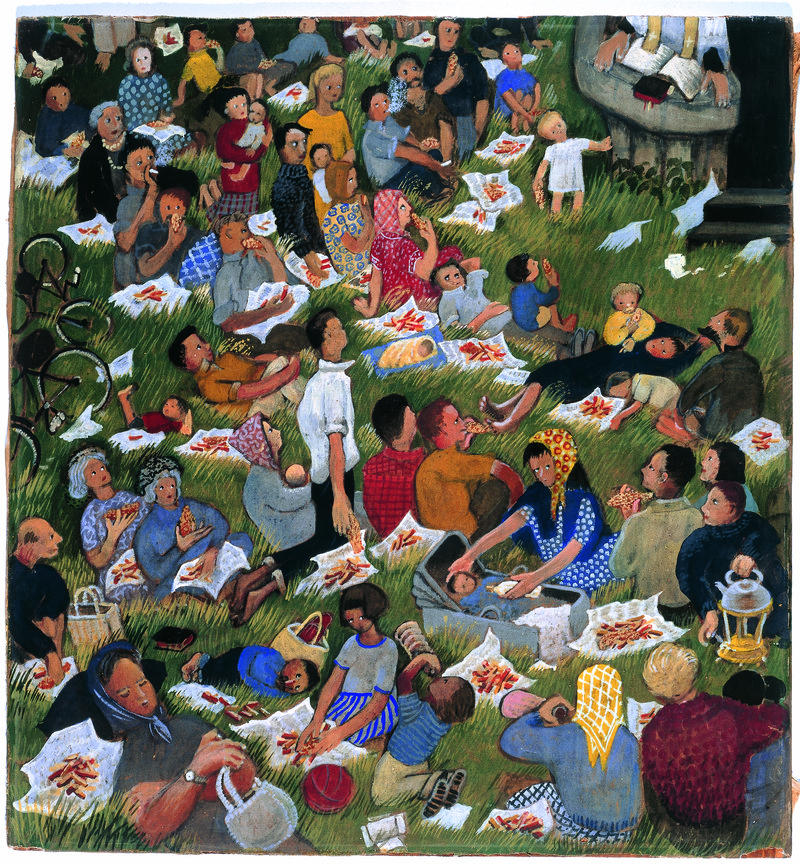
The Five Thousand, 1962
Eularia Clarke (1914-1970)
Oil on canvas laid down on board, 65 x 62 cm. Methodist Modern Art Collection, MCMAC: 010
Image Copyright © Trustees for Methodist Church Purposes. The Methodist Church Registered Charity no. 1132208
Biblical commentary
Matthew 14:13-21
Eularia Clarke sets the feeding of the five thousand in modern dress and follows Matthew’s account in which women and children are present. The multitude has sat down in the grass, as Jesus requested, and is eating, not the fish and bread referred to in the Bible but, as in so much of Clarke’s work, a twentieth Century equivalent, fish and chips. The scene is more reminiscent of a church picnic than the biblical miracle. Tea is brewing in the lower right corner, bicycles and footballs are discarded, children and babies are remarkably well behaved, some people doze, others pay attention to the priest – or Jesus (whose head and shoulders are uncomfortably cut off by the edge of the painting). The artist said: ‘I daren’t paint Christ, I put in a pulpit, the priest is reading the notices before the sermon.’
Commentary based on A Guide to the Methodist Art Collection.
Artist biography
Born: London, UK, 1914
Died: Southampton, UK, 1970
Early life
Eularia Clarke was born in Notting Hill, London, into a liberal intellectual family with clerics and artists on both sides.
Education
Clarke read Theology at Oxford University and studied painting at the Ruskin School of Art in her spare time. Her tutors included Gilbert Spencer, brother of Stanley Spencer.
Life and career
In the first two decades of her adult life, Clarke painted mainly landscapes and portraits. She fitted this in with bringing up her children as a single mother and teaching art in schools to support her family.
Clarke had been brought up in an Anglican environment but was received into the Roman Catholic Church in 1959. In 1960, after recovering from breast cancer, she went on a pilgrimage to Lourdes, which had an immediate impact on her art. She began a series of paintings depicting Roman Catholic worship and gospel stories. Like Stanley Spencer before her, almost all her religious paintings are set in the twentieth century. However, Eularia’s biblical scenes seem more firmly rooted in everyday life than those of Spencer and her characters are portrayed with greater liveliness, warmth and affection. Between 1959 and 1970, she produced more than 90 religious paintings, making her one of the most prolific painters of religious subjects in the post-war era. As a woman, she often struggled to gain recognition from the clergy for her art. Yet she pursued her artistic practice with determination, resolving to make the Gospel accessible to all.
She wrote articles on faith and art for national publications and became well known in the south of England through appearances on the BBC and Southern Television.
In the last two years of her life, she continued to paint and exhibit even though her cancer had returned and she was experiencing depression. Her career was cut short by her death at the age of 56.
Her active period as a painter of religion lasted only 12 years. This was limited at one end by raising and supporting a family and at the other by her illness and early death. Eularia refused to sell her works, so her paintings stayed within the family and remained largely unknown. The two paintings in the Methodist Modern Art Collection (The Five Thousand and Storm over the Lake) were an exception.
Importantly, her career was also limited by her gender. Women artists were undervalued, and Clarke died just as they were beginning to assert their presence in the male-dominated artworld. Her work has become better known and appreciated in recent years. This is thanks to regular showings of her two works in the Methodist Modern Art Collection, the work of the Eularia Clarke Trust, and the biography written by her granddaughter, Rebecca Sherlaw-Johnson.
Exhibitions and collections
Clarke exhibited her works mainly in educational and church settings including Imperial College London (1968); and Portsmouth Roman Catholic Cathedral (1969). Her commissions included The Last Supper for the Catholic Chaplaincy of Southampton University (1962); and Stations of the Cross for St Joseph’s Church in Havant, Hampshire (1967).
Sources and further reading
Lecture by Corinne Miller, Vice Chair of the Methodist Modern Art Collection Management Committee: https://vimeo.com/1093049568
-
Artist’s website: www.eulariaclarke.co.uk (viewed 18 September 2024)
David Buckman, Artists in Britain Since 1945: Volume 1 A to L. Vol. 1 of 2 volumes, (Bristol, Art Dictionaries Ltd, 2006), p. 290
Seeing the Spiritual: A Guide to the Methodist Modern Art Collection, (Oxford, Methodist Modern Art Collection, 2018), p. 32-35
Rebecca Sherlaw-Johnson, Eularia Clarke: Painter of Religion, (Stonesfield, Oxon, Books with Spirit, 2017)
Roger Wollen, Catalogue of the Methodist Church Collection of Modern Christian Art with an Account of the Collection’s History, (Oxford, The Trustees of the Methodist Collection of Modern Christian Art, 2003), p. 56-60